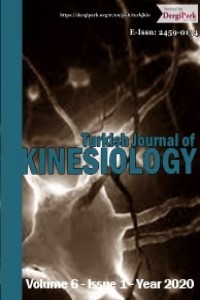The importance of relevant criteria of selection in ensuring the success of the national selection systems in athletics: A review
The importance of relevant criteria of selection in ensuring the success of the national selection systems in athletics: A review
athletics, selection criteria selection system, specialization,
___
- Abbott, A. J. (2006). Talent identification and development in sport. Doctoral Thesis, Edinburgh.University, UK.
- Bailey, R. & Collins, D. (2013). The standard model of talent development and its discontents. Kinesiol Rev,.2, 248-259.
- Bompa, T. O. (2002). Periodization: Theory and methodology of training. București: EX PONTO Publishing House.
- Dabbs, T. J. (1992). Performance prediction in track and field. Master's Thesis. Western Michigan University, Kalamazoo, Michigan, USA.
- Dulceanu, C. R. (2011). Contributions on the optimization of the selection system in first formative/stage/in/athletics. Master's Thesis, University.of.Pitești, Pitești, Romania.
- Dulceanu, C. R. & Mihăilescu, L. (2011). Contributions regarding sport selection and orientation for the first formative stage in athletics. Journal of Physical Education and Sports, 11(3), 329-335.
- Freitas J. V., Werneck F. Z., Souza R.S., Castro P.H.C., Figueiredo A. J. & Lima J.R.P. (2020). Maturation, morphological, motor and technical characteristics of under 16 female track and field athletes. Rev Bras Cineantropom Desempenho Hum, 2020, 22, e68128.
- Guellich, A. E. & Emrich, E. (2012). Individualistic and collectivistic approach in athlete support programmes in the German high-performance sport system. Eur J Sport Soc, 9(4), 243-268.
- Houlihan, B. & Green, M. (2008). Comparative elite sport development: systems, structures and. policy. Burlington, USA: Elsevier Publishing House.
- Idrizović, K. N. & Nićin, D. (2014). The selective battery of motor tests for a track and field event long jump. Sport Sci Health, 4(1), 20-32.
- Krasilshchikov, O. (2013). Talent identification an development-Reassessing the Principle Model. Acta Facultatis Educationis Physicae.Universitatis.Comenianae, 53(1), 25-32.
- Mihăilescu, L. N. (2005). Athletics: Hurdles. Chișinău: Valinex Publishing House.
- Moskovchenko, O., Ivanitsky V., Zacharova, L.& Shubin, D. (2018). Morphofunctional markers of kinetic aptitude in a sport -selection system. Journal of Physical Education and Sport, 18(2), 670-677.
- Nicu, A. (1993). Modern Training. EDITIS Publishing House.
- Platonov, V. (2018). Theoretical and methodological background for sports selection and orientation in modern elite sports. Science in Olympic Sport, 3, 24-51.
- Prescot, J. (1999). Identification and development of talent in young female gymnasts. Doctoral Thesis, Loughborough University, UK.
- Sumantri, M., S., Hidayat, D., R., & Juriana, J. (2021). The urgency of sports talent instruments: Perspectives of early childhood teachers in Indonesia, Journal of Physical Education and Sports, 2(suppl. Issue 4), 2343-2349.
- Vaeyens, R., Gullich, A., Warr, C. R. & Philippaerts, R. (2009). Talent identification and promotion programmes of Olympic athletes. J Sports Sci, 27(13), 1367-1380.
- Weissensteiner, J. (November, 2016). From active lifestyle to sporting excellence: Deconstructing the FTEM framework and its applicability within Australia. NYSI Youth Athlete Development Conference. https://www.nysi.org.sg/qql/slot/u736/TID%20Conference/PowerPoint%20Slides/4.%20Dr._Juanita_Weissensteiner.pdf
- Yayın Aralığı: 4
- Başlangıç: 2015
- Yayıncı: Nurtekin Erkmen
Senem DEMİRDEL, Gülşah GÜL, Öznur GÜMÜŞ, Betül KUZ
Ramazan BAYER, Hadi NOBARI, Özgür EKEN, Serdar BAYRAKDAROĞLU, Hürmüz KOÇ, Elena Mainer PARDOS, Fatma Hilal YAĞIN
Muhammed Zahit KAHRAMAN, Sedat OKUT, Cengizhan SARI, Ömer Faruk BİLİCİ, Fatih BİLİCİ
Alına Ionela PREDESCU, Liliana MİHĂİLESCU
Evaluation of agility and acceleration levels in male and female futsal players
Investigation of nutrition knowledge levels of basketball coaches working in Karaman city center
The study of relative age effects on weightlifting athletes in U15 and youth age groups
The influence of active breaks in the long jump on sports performance
Calfa HORATİU, Liliana MİHAİLESCU
Acute effect of different blood flow restriction protocols on muscle damage
Effects of foot preference on postural control in soccer players
